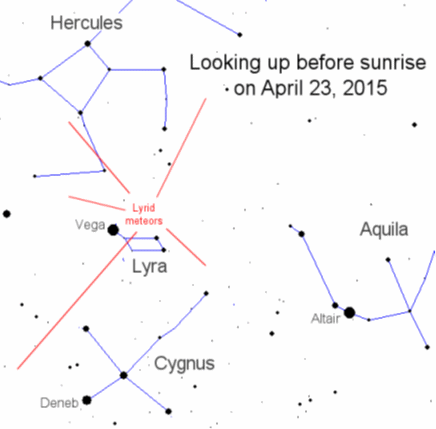It is therefore worth going out after the Independence Day celebrations to a dark place, and watch the meteors that originate from the remnants of particles left by comet Thatcher, and they appear to come from the constellation Nebula (Lyra). The suitable hours for viewing are from 23:00 until sunrise

Today, April 22, Earth Day is being celebrated around the world with the aim of raising awareness of maintaining a healthy and clean environment on Earth. This year, Earth Day ends with a celestial event - the climax of the meteor shower for fairs.
It is therefore worth going out after the Independence Day celebrations to a dark place, and watch the meteors that originate from the remnants of particles left by comet Thatcher, and they appear to come from the constellation Nebula (Lyra).
When the Earth crosses the area where these fragments are located, these pieces of dust, which are the size of grains of sand, move at a speed of 49 kilometers per second and break up in a flash of light. A typical Lyrid meteor as bright as the stars of the Big Dipper.
Forecasts predict that this year's meteor shower will be relatively moderate. In most years, this shower produces 10-20 meteors per hour, but sometimes when the Earth passes through an unusually dense mass of debris from Comet Thatcher, the rate increases - a phenomenon known as a meteor burst. Sky watchers in 1962 saw 90 liraids per hour. An even larger outbreak was described in 1803 by a journalist in Richmond, Virginia who wrote:
"Falling stars were observed early Wednesday morning from Richmond and its vicinity, in such a quantity that it frightened many and amazed every person who saw them. From one o'clock to three o'clock in the morning, these stars are seen falling from every point in the sky in such numbers that they resemble a shower of rocks from the sky."
In another event in the 19th century, 167 meteors were counted within fifteen minutes, and there were probably many more.
Such an eruption is not expected in the meter of 2015, but it was not predicted in the previous times either, so it is better to go outside, says NASA
The best time to view the meteor will be from 23:00 PM on April 22nd until sunrise on April 23rd in any Northern Hemisphere time zone.
Tips for observation: wear warm clothes, bring chairs or spread a thick blanket on top of a flat area on the ground, lie down and look up. The meteors can appear in any part of the sky, although their origin will be from the nebula group, which gave the shower its name. The hours before sunrise are the best because that's when the harp group is in the sky.
Sometimes a bright moon can spoil the experience of watching meteors, but this time it doesn't happen, on the fifth day of the Hebrew month (Thu Bayer) the moon is only a narrow crescent and will set a little after sunset, so that the moonlight will not interfere with the fairs. If you can get away from the city lights to where the sky is darkest to watch the best show possible.

One response
"Sometimes a bright moon can spoil the viewing experience"
Tl
The moon will not interfere this time, but the clouds apparently will...